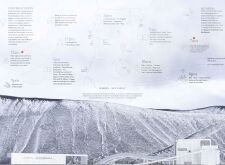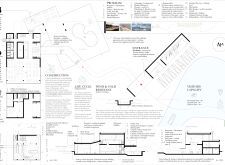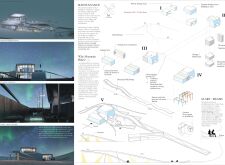5 key facts about this project
This architectural design represents a response to the need for spaces that foster connection with the breathtaking Icelandic terrain. The center is intended to provide a variety of functions, including recreation, education, and community engagement, all while enhancing the experience of exploring the natural beauty surrounding it. The design encourages visitors to immerse themselves in the landscape, with a layout that highlights key views and pathways.
Prominent features of the Hvítserkur Center include its straightforward yet elegant spatial arrangement. The center comprises essential areas such as a reception, a café, exhibition spaces, and outdoor seating. Each section has been purposefully crafted to enhance visitor flow and facilitate a welcoming atmosphere. Notably, the design employs a modular approach, allowing for future adaptability in response to evolving visitor needs or environmental changes.
The project employs a carefully considered palette of materials that reflects its commitment to sustainability. Recycled steel sheets form the structural components, providing durability while remaining environmentally conscious. The turf roof is another significant feature, contributing to thermal insulation while blending seamlessly with the surrounding topography. Large triple-glazed windows maximize natural light and offer unobstructed views of the enchanting landscape, reinforcing the connection between the interior spaces and the external environment.
Unique design approaches are evident throughout the project, particularly in its emphasis on movement and interaction. The architecture acknowledges the varying rhythms of nature, as seen through the integration of pathways and recreational areas that facilitate exploration. Daytime activities can include hiking and outdoor seating, while evening engagement may focus on stargazing or enjoying the northern lights. This dynamic interaction approach enhances the visitor experience, promoting a deeper appreciation for the natural surroundings.
Particular attention has also been given to the project's landscaping, which incorporates native vegetation. This choice not only supports local biodiversity but also further immerses the center in its ecological context. The sustainable landscaping design reflects broader considerations in architecture regarding the importance of ecological stewardship.
The Hvítserkur Center stands out in its dedication to creating a meaningful relationship between people, architecture, and the landscape. It is a project that prioritizes not only its aesthetic and functional aspects but also its role in promoting sustainability and community engagement. By combining various architectural elements, the design fosters a sense of belonging and appreciation for the Icelandic environment.
For those interested in exploring the project in greater detail, including its architectural plans, sections, designs, and innovative ideas, a thorough examination of the comprehensive presentation is encouraged. This exploration will provide insights into the thoughtful architectural processes that shape the Hvítserkur Center, illustrating its role as a model for future projects in environmentally sensitive areas.


























